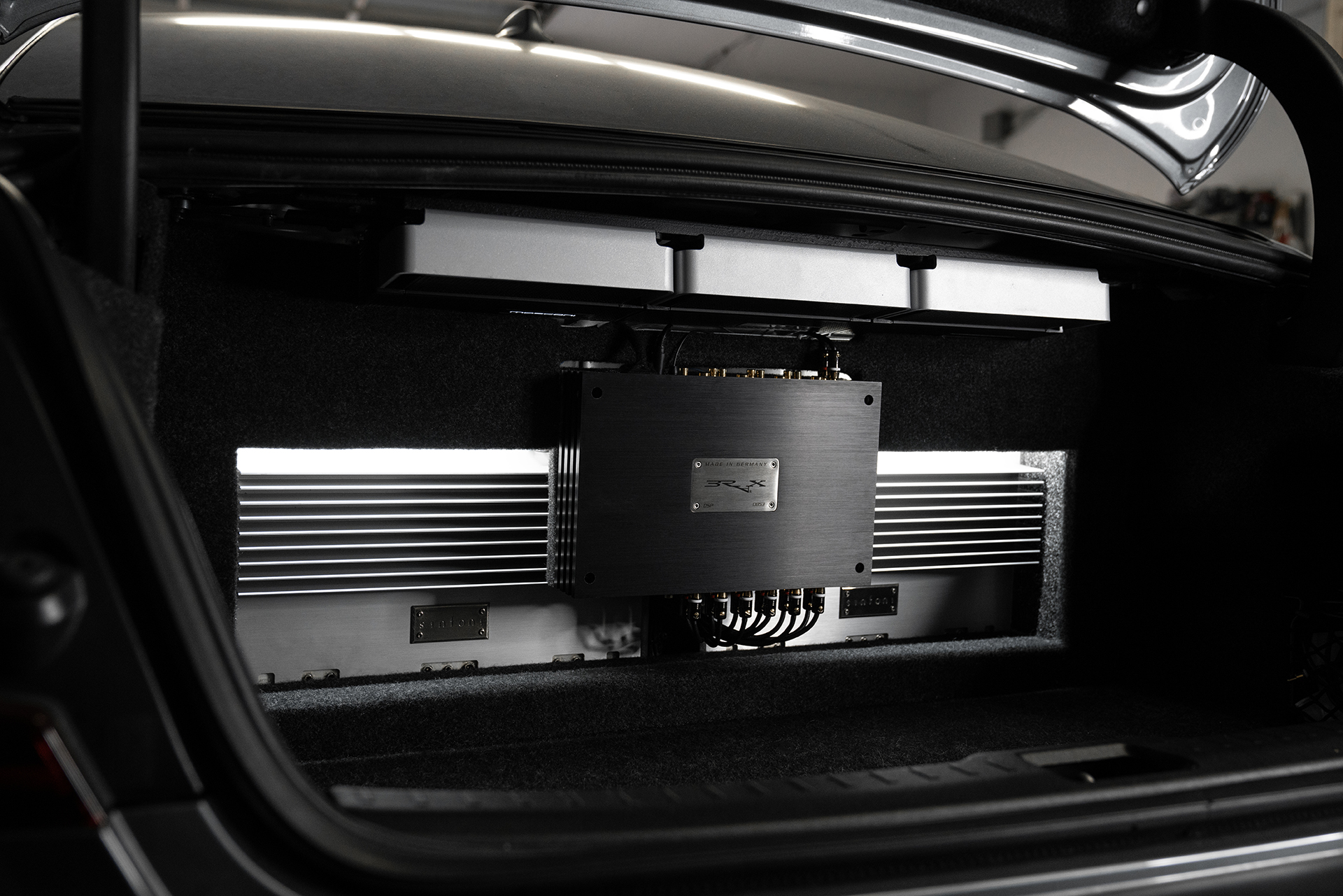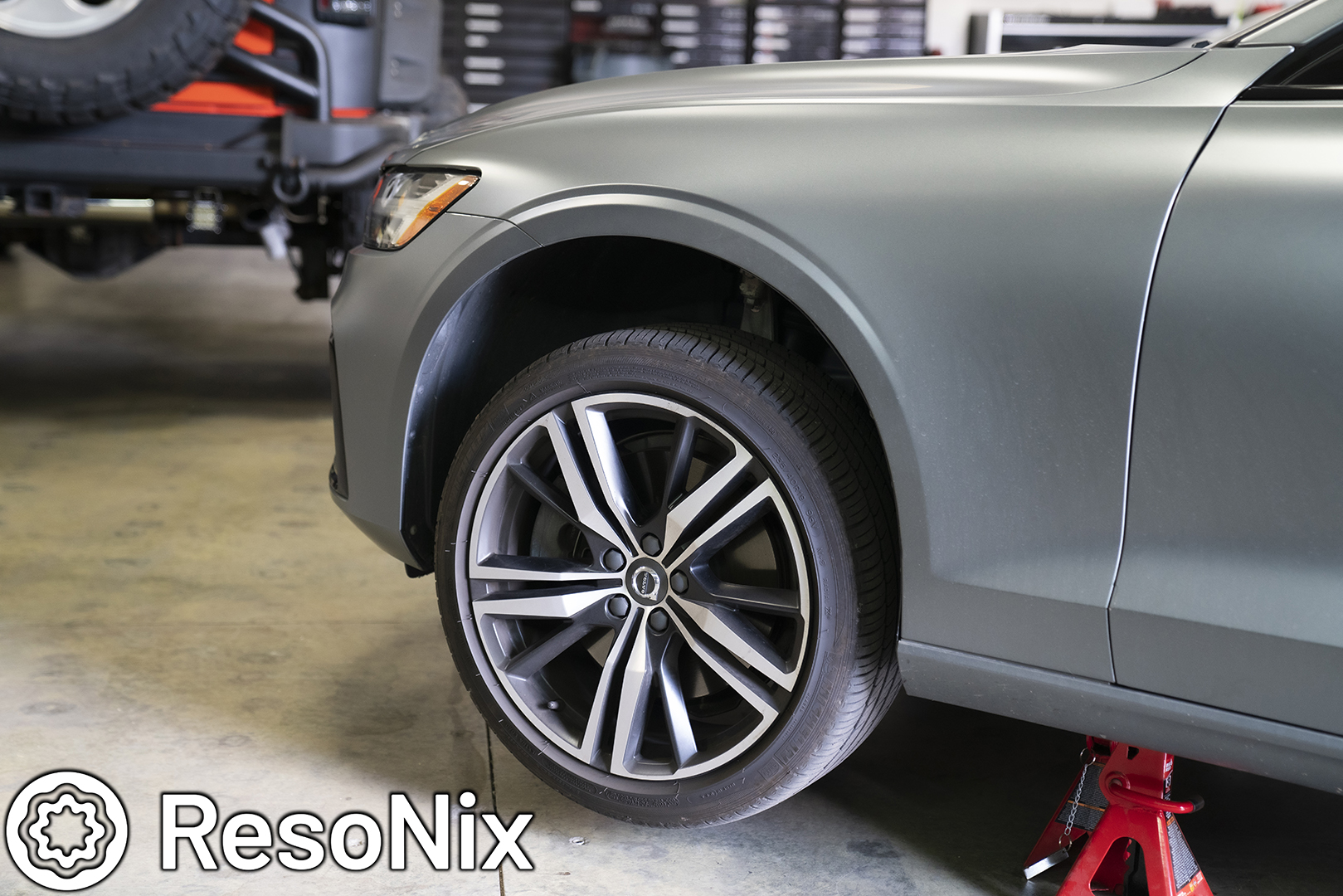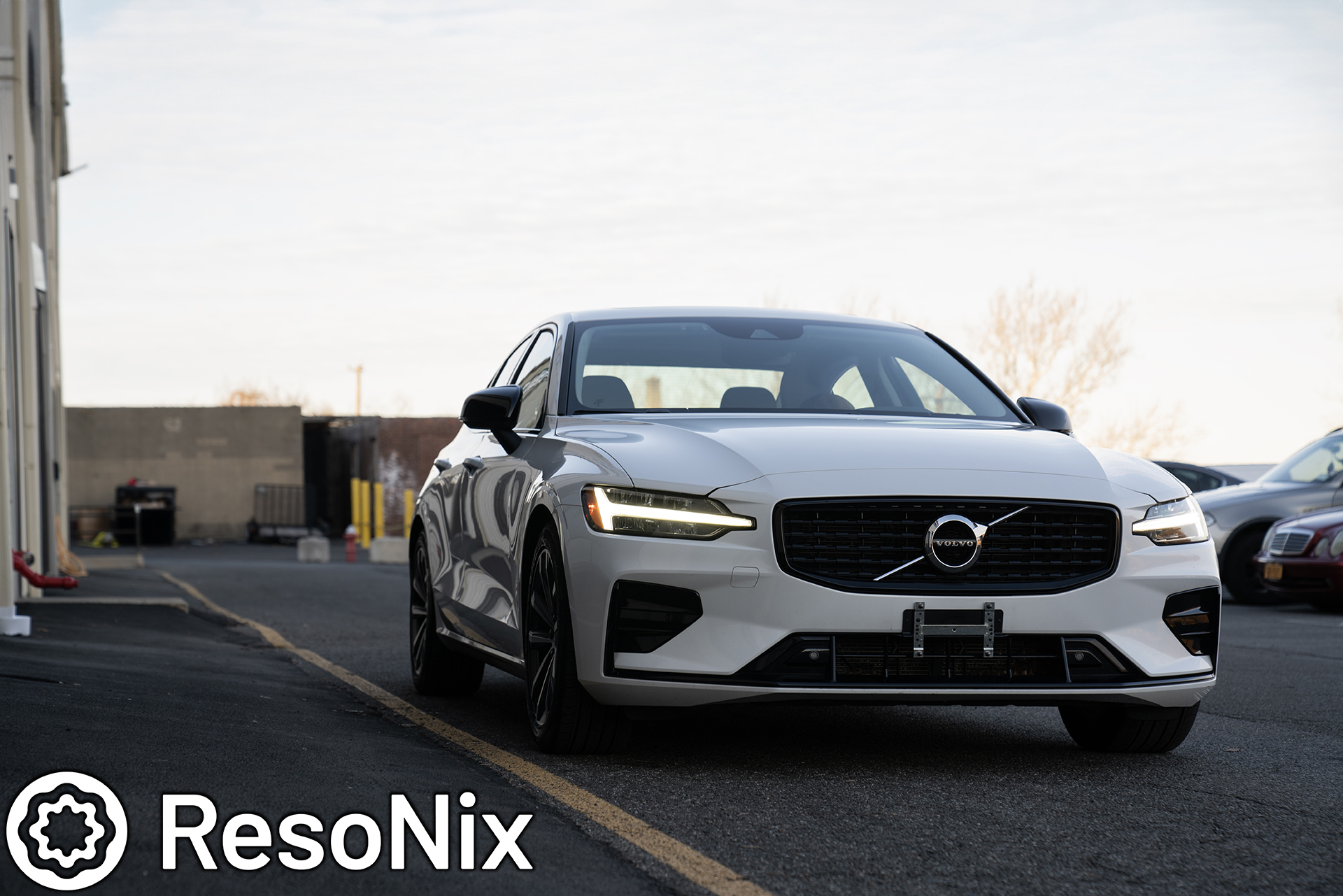
2019 Volvo S60 R-Design – ResoNix Sound Solutions Demo Vehicle Car Audio Installation
2019 Volvo S60 R-Design – ResoNix Sound Solutions Demo Sound System Elevating Sound and Functionality: The Ultimate 2019 Volvo S60

Added 11/13/2022
Supplies needed
. ResoNix Fiber Mat 0.5″ and/or 1.0″ (depends on how much space you have and what you can fit)
. Optional and preferred: ResoNix Barrier
Note: ResoNix Fiber Mat is perfectly fine in this location and exposed to the elements. It will not hold water, it will not degrade, it will not grow mold or mildew. This is the very same material that is used in these locations by car manufacturers such as Mercedes.
Wheel wells are one of the most offensive sources of noise in a vehicle.
Tire Noise: This is generated by the interaction of tires with the road surface. Different textures and materials on the road can cause varying levels of noise. For example, rough asphalt or gravel produces more noise compared to smooth tarmac. The noise is primarily due to the vibrations and air being compressed and released by the tire treads as they make contact with these surfaces.
Impact Noise: When a vehicle travels over bumps, potholes, or debris, the impact is transmitted through the tires and into the wheel wells. This impact creates noise, which can be directly transmitted into the cabin if not adequately insulated.
Spray and Debris: In wet conditions or on loose surfaces like gravel, particles can be thrown against the wheel wells. The sound of these materials hitting the metal or plastic of the wheel wells can be quite loud, adding to the overall noise level inside the vehicle.
Structural Transmission: Noise from the wheel wells can be transmitted to the vehicle’s cabin through the vehicle’s structure itself. The metal and other materials used in car construction can conduct sound waves from the wheel wells into the cabin.
Airborne Transmission: This type of noise spreads through the air gaps and enters the cabin through openings or less insulated parts of the vehicle’s body. Even small gaps can significantly affect how much road noise enters the cabin.
Damping Materials: Applying damping materials like mats or pads made from dense material, such as our ResoNix CLD Squares, reduces the airborne transmission of noise through the wheel liners caused by road noise. While ResoNix CLD Squares are typically used to reduce resonance by constraining the panel, they can, in this VERY specific case, work as a mass loaded noise barrier since the wheel liners will not really be able to transmit mechanical energy into the cabin. It works by adding mass to the wheel wells, thereby reducing the ability of the structure to vibrate and transmit noise. Again, this is not the main point of CLD sound deadening materials, but it will behave this way in this specific instance.
Absorptive Materials: ResoNix Fiber Mat can be used to line the wheel wells. This material absorbs sound waves, preventing them from reflecting off the hard surfaces of the wheel well and entering the cabin.
Barrier Materials: Heavy, dense materials, such as ResoNix Barrier, can act as a sound barrier, blocking the direct pathway of noise into the vehicle cabin. These are usually installed as part of a composite system that includes both absorptive and damping materials. As mentioned before, the ResoNix CLD Squares pretty much take on this role, but adding ResoNix Barrier allows even further noise blocking. This is only for advanced installations though as it will be difficult to install.
By mitigating the noise originating from the wheel wells, the overall noise level inside the cabin is significantly reduced, leading to a quieter and more enjoyable driving experience. This reduction in noise can decrease driver fatigue, increase the effectiveness of in-car communication and multimedia systems, and generally make the vehicle feel more refined and comfortable.
In essence, soundproofing the wheel wells addresses one of the primary entry points for external noise into a vehicle, making it a key area to target for those looking to enhance their driving experience through noise reduction.
Below is what I did in my own vehicle, a 2019 Volvo S60 R Design. Please note, that the exact approach will be different on every vehicle. This can be due to how much room there is to work with, moving parts, or more. Please use your best judgment.
First up is obviously removing the wheels and wheel liners. During this process you are going to want to evaluate what you can fit, what parts of the body of the vehicle are going to need the most attention, etc. Remember, resonant panels will need it most. Its crude, but a simple knock with your knuckle will let you know what parts of the body need treatment. More on this part below, but on this particular vehicle, the body was relatively non-resonant, and the wiper fluid reservoir blocked a lot of access on the drivers side. Due to this being planned as a few hour-long project and was recovering from a medical procedure, I did not decide to remove the reservoir and instead worked around it. While getting a closer look, I also noticed that I had gained access to the back side of the fender and the airspace behind it. I decided to also apply ResoNix CLD Squares to the back of the fender and apply ResoNix Fiber Mat 45 on top to fill the airspace.
Next up, treating the wheel liners with ResoNix CLD Squares. Before you do anything, you should clean the liner with isopropyl alcohol thoroughly. In some cases, it is even recommended to sand the plastic with a low-grit paper to encourage the best adhesion possible. In my case, I didn’t feel it was necessary considering how well the ResoNix CLD Squares adhere to pretty much any material and surface you will find in a car.
Once you have the panel prepped, apply full coverage of ResoNix CLD Squares. In the case of doing wheel liners, I wouldn’t recommend less since the liners are mostly decoupled from the body of the vehicle, so not only do you get resonance control of the plastic liners, but it also acts as a noise barrier. Remember, treat all panels in the largest pieces of CLD Squares possible.
Note: We will only be treating the back side of the liner. Leave the exposed side untouched.
Optional: if you have the time and budget, I would also suggest a full coverage layer of ResoNix Barrier over the layer of CLD Squares for further noise blocking. In my case, I did not add this as I was restricted on time, and was recovering from a medical procedure and couldn’t afford the even heavier lifting that Barrier would impose.
Once the liner is fully treated with ResoNix CLD Squares, we can start our full coverage application of Fiber Mat 45. Remember, when it comes to absorption, more is merrier. Full coverage is highly recommended, and if you can fit, the more layers the better. Be sure to take note of suspension components, wiring, or any other parts of the car that may need to be worked around.
Once the wheel liner is covered, that’s it. You’re nearly done and its almost time to re-install it. Before re-installing it, you should explore treating the body of the car with ResoNix CLD Squares. Once that is done, re-install the liner and enjoy 🙂

2019 Volvo S60 R-Design – ResoNix Sound Solutions Demo Sound System Elevating Sound and Functionality: The Ultimate 2019 Volvo S60

Elevating the Volvo S60 Experience: A nearly completely hidden sound system upgrade with one extra goal; to keep it OEM

ResoNix Sound Solutions is a company with a specialty in high-end car audio and automotive sound treatment that offers top quality products and services that provide superior performance in their respective categories. No gimmicks, no baseless claims, no nonsense. Constrained layer dampers, sound absorbers, decouplers, noise barriers, and car audio DSP tuning and consultation services are part of our line-up with a focus on data-backed, solutions-based products developed by professional enthusiasts, for enthusiasts.
